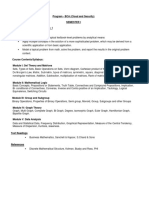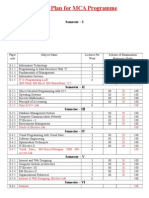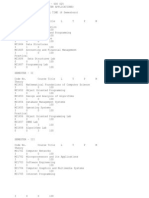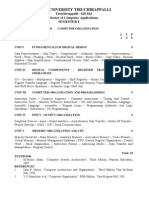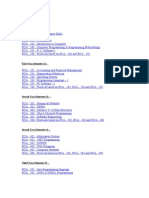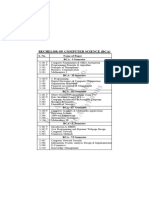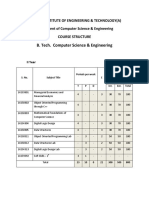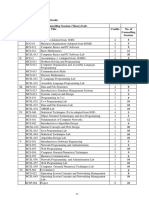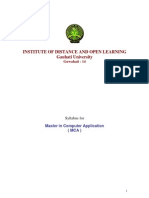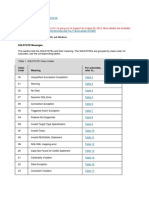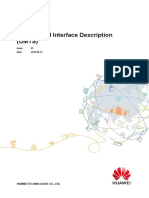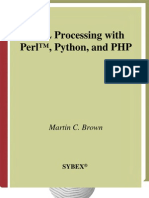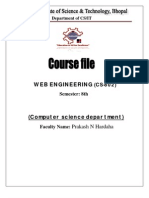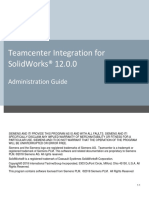BACHELOR OF E-COMMERCE (FIRST SEMESTER)
COURSE 101: e-Commerce And Business Strategy
Introduction : E-Commerce over Internet, Internet-Commerce Applications, Electronic Communication “PC’s
and Networking and e-mail” Electronic data interchange; cost and benefits of EDI system EDI software and
EDI implementation issues. e-Commerce growth, its securities, e-Banking, e-Commerce in India: Custom,
Banks, Airport Authority of India Port, Authority, Law of e-Commerce.
COURSE- 102: Introduction To Computer Fundamentals And Information Technology
PART A: Basic Computer Concepts History of Computers and its Evolution
1. Basic Computer Organization (Function Limit Organization)
2. Computer Languages- Machine, Assembly, High level languages, Interpreter, Assembler, Computers.
3. Operating System Fundamentals-Evolution, Definition and functions, Batch Processing, Job Control
Language, Sporting Multiprogramming, Multiprocessing, Time sharing, On-line Processing Real Time
Processing Virtual storage.
4. Data Communication Computer Network Data Transmission Modes: Simplex, Half Duplex, Full
Duplex Data Transmission Speed: Narrow Band, Voice Band, Broad Band.
Digital Transmission Media: Wires, Coaxial, Microwaves, Communication Satellite Optical Fibers.
5. Network Topologies- Star, Ring, Completely connected, Hybrid, Multipoint, LAN and WAN Networks.
PART B: Programming
1. Algorithms
2. Flow Chart-Symbols, Sample flow Charts, Levels in Flow charts, Flow Charting Rules, Advantages
and Disadvantages of Flow Charts.
3. Decision Tables & Pseudocode.
4. Programming Concepts- Monolithic, Structured, Object Oriented, Variables, Constants, Arrays,
Function, structured, Classes, Objects, Pointers, Files Subprograms .
5. Standard Algorithms- Sorting Algorithms: Bubbles Operations, Radix, Solution, Matrices Operations:
Addition, Subtraction, Multination, Scalar Multiplication, Merging.
6. Exchange/Insertion in Arrays, sine/Cosine/Exponential Series, Fibbonacci Series Algorithms.
COURSE – 103: Marketing Communication:
Nature and Importance of Communication. Communication Process. Elements of the Communication
Process, Application of Communication Process in Marketing Steps in Developing Effective Marketing
Communication. Methods of Marketing Communication.
COURSE – 104 : Business Organization
UNIT 1: Introduction: Concepts and objectives of business organization, establishment of a new business,
pre establishment consideration, social responsibility of business.
UNIT 2: Business Environment: Type of economy-Socialistic, Capitalistic, mixed, factors influencing the
Business environment, Economic or Non-economic factor, Internal & external factor etc.
UNIT 3: Forms of Business Organization: Sole trader ship: Meaning, characteristic, features and legal
requirements. Partnership firms: meaning, partnership deed and legal requirements as per partnership act.
1932 . Joint stick concerns: meaning features kinds of companies, legal requirements as per company act
1956.
UNIT 4: Business Finance: Finance concept, need and significant, methods of finance: long term, medium
tern & short term finance (national), international finance, financial institution: brief introduction to IFCI, SFC,
ICICS, IDBI, Security Market: An introduction to primary & secondary market.
COURSE – 105 LANGUAGE AND COMMUNICATION
Essentials of Grammar: Articles: Definite, Indefinite. Verbs: Regular, Irregular, Transitive, Intransitive.
Tenses: Past, Present, Future, Past Participle, Present Participle, and Auxiliaries. Modals: Can, May, Might,
Must Should. Degrees: Positive, Negative Superlative, Comparative Active- Passive Voice, Direct/Indirect
Speech, Prepositions, Punctuation, Organs of speech.
COMPOSITION: 2 essays on IT Topics (internal), 2 Business letters (internal) Reading comprehension,
Computer Terminology. Writing skills: Précis Writing, Business Letters, and Formal Report, Fact sheets
COMMUNICATION SKILLS: Functions of Communication, Communication Process, Direction of
Communication, Formal Vs Informal Networks, Choice of Communication Channel, Barriers to Effective
Communication, Listening Skills
PDP: Vocabulary, Pronunciation, Debate, Presentation (internal)
COURSE- 106: Principles of Management
Concepts, Definition, Characteristics, Importance, Functions and Nature of Management, Meaning
Characteristics, Importance, Process, Principles and Limitation of Planning Meaning and Process of Decision
Making, Meaning and Characteristics, Theories of Motivations, Maslow Hierarchy of needs theory, Herzberg
Theory, The expectancy Theory.
Definition, Characteristics, Objectives, Principles Forms and Process of Organization. Organization Structure:
Meaning and Factors Affecting Organization Structure.
1
�Delegation of Authority: Definition, Characteristics and Principles, Delegation vs. Decentralization;
Centralization and Decentralization. Leadership: Meaning, Characteristics and Styles of Leadership,
Definition. Characteristics and Process of Control.
2
� BACHELOR OF E-COMMERCE (Second Semester)
Course – 201: Digital Electronics
Binary Numbers, Number Based Conversions, Complements (1’s & 2’s Complements) Logic Gates: AND,
OR, NOT, EX-OR, examples as Switching circuits; Boolean Algebra: Basic Laws of Boolean Algebra, De’
Morgan’s theory, Sum of Products and Product of sums, Derivation of products and sum expression, NAND
and NOR Gates; K-Maps for 1, 2, 3 and 4 Variables.
Chip forms (RS, D, JK and Master Slave Flip Flops), Registers, Shift Registers Counters, BCD, Binary,
Johnsun master, Multiplexer and Demultiplexer.
Memory Organization- RAM, ROM, Disks, Tapes Cache, Associate, Virtual Memories, Multiplication
Algorithm. (ALU)- includes H/W algorithm, BOOTHES Multiplication algorithm with flow charts.
Division Algorithm of signed Magnitude of date, divide overflow using Vestoring/Nonvestoring methods.
COURSE 202: Statistical Techniques and Decision Analysis in I.T.
Probability and Probability Distribution: Basic concepts of Statistics, Basic concepts of probability,
discrete probability distribution, continuous distribution. Forecasting Methods: Business forecasting,
Co-relation Regression, time series analysis, exponential smooth techniques, application in I.T.
Decision Making: Criteria for Decision Making under Certainty, maximax and maximim, minimax,
regret and expected value criteria, decision making under risk utility as a decision criteria and
excepted value perfect analysis. Decision Analysis: Programming Formulation, Linear programming
Simplex method, duality, sensitivity analysis, transportation problem, assignment problem, inventory
control, network analysis, CPM and PERT, sequencing, game theory.
COURSE 203: Introduction to “C” & Programming in “C++”
Introduction of “C”: Basics Control Structures, Looping “C++” Getting Headway:- Data types,
Constant, Header files, operators, examples. Functions Storage Classes, scope, control structures,
Classes/Objects:- Classes, Objects, Access Specifire, Constructors/Destructors,
Polymorphism:-Function over loading, Friend function,
Pointer:- Operator over loading, input output
Inheritance:- Inheritance basics, Multiple inheritance
Files.
Lab:I: Introduction to “C” & Programming in “C++”
Usage of the basic programming concepts in C: Addition of 2 numbers, formatted output,
Palindrome of numbers
Control Programs: Usage of various control statements: In finding the series (Exp, sin, cos.),
Fibonacci series
Arrays: Use of arrays to perform sorting, selection sort, bubble sort, insertion/deletion from array.
String functions usage, Palindrome of strings, Sorting of strings.
Usage with/without function prototype- calculate tax 10 people, pass by reference/value, Recursive
program (Function)
Structures: Maintain student records using structures.
Pointers: Usage of basic pointer with arrays pointer with structures
Creation of class data types, member functions and data access member functions, use of member
function of a class outside its scope.
Perform complex number arithmetic operation using oops technique
Creation for student details (roll number, name, age, sex, height, weight) by using pointer in classes
Programs dealing with the usage of constructors, default/parameterized generating fibonacci series,
usage of destructors
Programs using static class and static data members, friend functions, usage of this pointer.
Programs dealing with single, multiple, multilevel inheritance, programs dealing with Protected,
public and private inheritance.
Function overloading, dealing with ambiguities, operators overloading function and constructor
overriding.
3
� COURSE 204: Web Technology and Design
HTML Introduction to Internet; WWW: HTML Document
- Markup Tages:- HTML; HEAD, TITLE; BODY; PRE; LIST; HR; BR
- Formatting:- MARQUEE; BOLD; ITALICS; SUBSCRIPT;
- Linking:- URL; Relative Path Vs Absolute Path names.
- Images, Tables, Frames
- Form Elements: Text Buttons; Textarea; List; Reset, Submit, Radio buttons; Checkbox.
DHTML Cascading Style sheets; Dragging; Dropping; Layers, Div tag: Animation
Java Script
- Introduction to Java Script; Hierarchy Model; Java Script Vs Java
- Declaration and Expressions
- Control Structures and Functions
- Variable Scope:- Global Vs Local
- Objects in Java Script:- Properties, Methods.
Array Object, Date Object, Math Object, String Object
- Events in Java Script
Onblur, onclick, onchange, onfocus
- Browser Objects
- Design of interactive Forms
- Image Handling
- Layers
VB Script
- Introduction to VB Script
- Fundamentals of VB Script:-
Variable, Strings, Constants, Date and Time arrays
- Control Structure :-
Decision making, Looping
- Sub Procedures
- Objects Methods and events
- Data Validation
Lab Schedule :
Practice on hands in designing form elements in a web page, associated events, programs such as DIGITAL
CLOCK, CALCULATOR, INTERACTIVE WEB PAGE.
Events in java Script, Function, Methods & Properties of Objects, Creation of on the fly documents, Object
Method of Java Script with extensive coverage to the client side scripting with life examples such as
dynamic web page all scripting validations & shopping cart. Lab in DHTML & VB Script will also consist of
examples from real life web page/ designs
COURSE- 205 : Advertising and sale promotion
Advertising, personal selling, public relations, sales promotion, Their meaning and distinctive characteristics.
Advertising Setting of Advertising objectives Setting of Advertising budget, Factor affecting the advertising
expenditure in a company Advertising message, preparing an effective advertising copy, Elements of a print
copy: Headlines, illustration, body copy, slogan, loge, seal of approval Role of Colon, Elements of broadest
copy for direct mail.
COURSE 206: Material Management and Stores Control
Material Management: Meaning, objectives scope and functions, Forecasting and planning of materials,
organization of materials management department.
Procurement of material: Purchasing function make, buy or lease decisions, buying process purchase price
analysis decisions and value analysis.
Concept, important and objectives of stores management
Procedure of receiving, checking and inspection of materials, Organization and layout of stores, classification
and codification of materials.
Meaning, objectives and mechanism of stores control, ABC analysis, calculation of safety stock. Inventory
carrying cost and ordering cost. Determination of EOQ.
Issue of materials: Procedure and Practice. Pricing of issue of materials, inventory control, its functions and
importance guidelines for inventory control.
4
� BACHELOR OF E-COMMERCE (THIRD SEMESTER)
COURSE 301: ADVERTISING AND PERSONEL SELLING
Advertising Media, Types of Media ( News Papers and Magazines, pamphlets, posters, Banners.).
Electronic Media(TV, Radio, Cassettes)
Media, Direct mail, outdoors media.
Their Characteristic, Merits and Limitations.
Media seems in India, Problems of reaching rural audience & Markets.
Exhibition & Mela (Fair) Pres Conference.
Medium Planning: Selection of Media, Category, Their reach frequency & impact, cost and other
factor, influence the choice of media.
Media scheduling
Nature: Importance of personal selling, Door to door selling, situation where person is more
effecting than advertising, cost of personal selling. Also model of selling. Type of selling situation,
types of sale persons, buying motives. Types of market customer and industrial workers, their
characteristic & implications for the selling functions.
COURSE 302: INDUSTRIAL ORGANISATION AND PERSONAL MANAGEMENT
Definition, importance and functioning of personnel management.
Evaluation of management through social responsibility of management.
Wages and salary administrations.
Employee’s appraisal, job analysis and description, recruitment, selection, placement, training and
development.
Motivation and theory of motivation.
COURSE 303: WEB DESIGNING & PUBLISHING PHOTOSHOP, COREL, GIF, ANIMATOR,
FLASH
Dream viewer:
Basic multimedia concepts - forms of multimedia, Positive & negative of multimedia, work of sound
engineer, inter engineer and contact developers.
Liquid crystal display (LCD) : Color specification, Comparison, Digital imaging, Postscript,
Encapsulated post scripts, JPEG, HFF, GIF Image, quality, storage, size etc.
Scanners Usages and Limitations.
PHOTOSHOP 5.5: opening, placing and saving images, photo CD files. Opening , saving files
(JPEG, GIF, TIF, EPS), using history palette, resolution and since issues. Copying and images,
images model converting from RGB to CMYK converting to gray scale, duotone, bitmaps magic
world tools, fading solution, creating a make for object with out cleared designing edges.
Transforming selecting areas- prospective removing key storing, pattern filling and usages of layers,
text on image wood text, metal text, color correction, working with path, package using, filters,
pagans adding- noise, papers publishing, half tones screens, applying trapping, electronic
publishing, saving FIF, JPG, PNG for the web, using web palette, aliening image and creating
image maps.
COURSE 304: INTRODUCATION TO COMPUTER NETWORK / INTERNET AND DATA
PROCESSING
Introduction to network concepts, Network topology, protocol(TIF). Introduction to Internet,
required hardware, role of modem, Internet service provider, setting on line and off line, browsing
with WWW, search and seizer, exploring with explorer, email teleconferencing, group-ware, work
flow, micro of multimedia in Internet.
Data Processing:- Introduction to data processing, records and files, data collection, preparation,
verification, editing and checking.
Overview old business functions. Use of computer system for business application, spread sheet
macros, use of spreadsheets in business.
Business files: Introduction to data structure, elements fields and records, classification of the
file, master file, transaction file, distributed processing, various facilities for business computing
and introduction to databases.
5
� COURSE 305: DATABASE MANAGEMENT SYSTEM
Data modeling for a database: Introduction to Database, Records & file, abstraction and data
immigration.
DBMS: Introduction to DBMS, Advantage and Disadvantage of DBMS. The three level
architecture of DBMS, components of DBMS.
Concepts based on ORACLE Database: Data models, and their implementations, relational,
network & hierarchical data models and manipulation relational algebra, relational calculus,
SQL(Structured Query Language).
Relation database design: Functional Dependencies, finding keys, 1 st to 3rd NF’s BCNF, losses
join and dependency preserving decomposition.
Query Processing: General strategies for query processing, query optimizations and query
processor. Concepts of security , concurrently and recover.
Data Design Project: Definition and analysis of existing system, Preliminary and final design
testing & implementation, operation running.
COURSE 306: VISAL BASIC 6.0
1. Introduction to Visual Basic 6.0
2. Concept of Programming
3. Visual Basic Controls
4. Number and string
5. Control statements
6. Menus and dialog boxes in VB
7. Graphics
8. Objects, Linking and Embedding
9. Working with files
10. Database & DBMS
11. Data Reports
12. Wizards in VB6.0 crystal reports
13. Basic of active X
14. Internet features of visual basic.
6
� BACHELOR OF E-COMMERCE (FOURTH SEMESTER)
COURSE 401 : Financial Accounting
1. Accounting Principles- Concepts & conventions, Principles of accounting, Indian & International accounting
standards.
2. Double Entry System- Journal, Classification of Journal, Cash book, Classification of ledger, ledger posting
sub division.
3. Preparation of Final Accounts- Preparation of Trial balance- Receipt and disbursement statement – Income
and Expenditure accounting-concepts of capital and Revenue expenditure, Profit & Loss Account, Balance
sheet with adjustments necessary for preparation of final accounts, Accounting errors & rectification.
4. Issues in the determination of income
Depreciation- Concepts methods
Inventory – Valuation- methods implications
COURSE 402: Commercial Arithmetic
Percentage, profit and loss, Ratio analysis, commission, Brokerage and premium. Share and stock.
Arithmetic Average-Simple and Weighted. Geometric Average-Simple and Weighted. Geometric Average-
Simple and Weighted, Simple and compound interest, Present value factor and annuity logs and reciprocals
linear equation Harmonic mean.
COURSE 403: Software Engineering
Chapter 1- Introduction to Soft ware Engineering : Introduction, Some Definitions, Some Size Factors,
Total Effort Devoted to Software, Distribution of Effort, Project Size Categories, How Programmers spend
Their Time, Quality and Productivity factors, Managerial Issues, Overview of the text, End notes. System
Analysis system design tools & Technique, prototyping, structured programming.
Chapter 2- Planning a Software Project: Introduction, Defining, the Problem, Goals and software
Requirement Specification (SRS), Developing a Solution Strategy, Planning the Development process, The
phase Life-Cycle Model, Implementation & Software testing, Black box Testing, Milestones, Documents and
Reviews, The cost Model, The Prototype Life-Cycle Model, Successive Versions. Planning an Organization
Structure, project Structure, Project Format/Functional format.
Chapter 3: user interface design: Elements, modern GUI, menus, panels, error messages etc
Chapter 4: user manual: User profiles, content strengths, and week ness of manual,
COURSE 404: Advanced Scripting Languages (XML, WAP, WML)
Introduction to WAP, Emergence of WAP, Features and services of WAP, Comparison of WEB and WAP,
Working of WAP, Components of WAP (Browsers, Gateways, Application Servers), WAP architecture,
Protocols Stacks, WAP development environment.
WML, XML: Introduction to WML & XML Anatomy, markups, elements, attributes, links, viewing in Internet
Explorer and other browsers, event driven programming, styling, formatting, links, inputs.
COURSE 405: Core Java
Overview of Java, Introduction to Object Oriented Programming, Introduction to network programming, data-
types, Variables, Variables, Arrays, Operators, Control Statements, Methods and Classes, inheritance,
Packages and Interfaces. Input output, Introduction to Applets.
COURSE 406: International Trade & Procedures
1. Introduction- Meaning & Scope of International Trade, Theories of International trade-Comparative cost
Theory, Modern Theory.
2. Balance of payments- Meaning, Accounting principles of Balance of Payment, Meaning of Deficit and
surplus in Balance of payments.
3. Trade Barriers & Economic Union-Meaning and different types of Trade Barriers, Meaning, scope and
advantage/Limitation of economic union
4. Foreign Exchange- Foreign Exchange Rates, Interest Rate, Import/Export License Open general License.
5. Export/Import Policies & Procedure FERA, FEMA, Letter of credit, shipping, Insurance, Income term etc.
6. International Organization- Word Bank IMF, WTO etc.
7
� BACHELOR OF E-COMMERCE (FIFTH SEMESTER)
Course 501: Logistic and Distribution Management
Channels for Distribution: types of channels, channels of functions, channels levels
Channels Design Decision: Analyzing customer desired service output levels, establishing objectives
and constraints identify major channels, evaluating the major alternatives.
Channel management decisions: Selecting channel members, training channel members, Motivating
channel members, evaluating channel members, modifying channel arrangements.
Channel Dynamics: vertical marketing system, horizontal marketing system , multi channel Marketing
systems, conflict, cooperation and competition, legal and ethical issues in channel relations.
Marketing logistics: Market logistic objectives, marketing logistics decisions, Organization lessons
about market logistics.
Course 502: Company Accounts
1. Statutory records of accounts to be maintained by a company.
2. Accounting for share capital transaction-opening of separate bank account, adjustment of
excess application money, issue of shares at par, at premium and at discount, accounting
treatment; accounting treatment and procedure relating to disclosure of premium and discount
in the balance sheet, brokerage and underwriting of shares, forfeiture and re-issue of share;
alteration of share capital; redemption of preference shares-statutory requirements; disclosure
in annual return/balance sheet.
3. Issue of debentures-accounting treatment and procedure relating to underwriting of
issue of debentures, redemption and conversion of debentures, acceptance of deposits-basic
requirements, treatment of interest, deduction and payment of fax, etc.
4. Accounting treatment for amalgamation, absorption and reconstruction of companies.
COURSE 503: Organization Behavior
Introduction to organizations and individuals. What is an organization, components of
Organization, nature and variety of organization (in terms of objectives, structures, etc.), models
of analyzing organizational phenomena, organizational and business variables, organizations in
the Indian context, institutions an structures, basic roles in an organization, etc. perceptions,
attitudes, motives (achievement, power of a manager and entrepreneur.
Interpersonal and group processes- interpersonal trust, understanding the other person form
his/her point-of view, interpersonal communication, listening feedback, counseling, transactional
analysis, self-fulfilling prophecy, etc. leadership, motivating people, working as a member of a
team, team functioning , team decision-making, team conflict resolution, team problem solving.
Organizational structure and integrating interpersonal and group dynamics- elements of
structure, functions of structures, dis functionalities of structures, structure-technology-
environment-people relationship, principles underlying designs of organizations; organizational
polities, issues of power and authority, organizational communications. Organizational charge.
COURSE 504: Server side Scripting (ASP, SQL Server)
Active Server Pages
• Introduction to ASP
• VB Script in ASP
• Built in Objects
• Database Programming
• Scripting Objects
• Active Server Components
Introduction to SQL, SELECT STATEMENT, Aggregate Functions, Group by clause, Having clause,
Order by clause, Combining conditions & Operators, IN and BETWEEN, Mathematical Functions,
Table Joins, SQL Interpreter
Table basics, Selecting data, Creating table, inserting into a table, Updating records, Deleting
records, Drop a table, Advanced Queries.
8
� COURSE 505: Advance Java (JDBC, Java Beans, JFC)
Client/Server model, Networking in JAVA, RMI, JDBC, JAVA beans, Servlets and CORBA
(Fundamentals, Server side Server side scripting servlets with JDBC, session tracking, Cookies
ORC rewriting), CORBA core Architecture, CORBA services. Introduction to Java foundation
classes and its features.
COURSE 506: Management M.I.S.
UNIT 1: DECISION MAKING & MIS
Structured and Unstructured Decisions, Information requirements for different decision making
strategies, Simon’s Decision making Model, Meaning, Nature, need, role, importance, calculation of
management through information system, Relatedness of MIS with management Activities,
management functions and decision making concept of ‘MIS’ effectiveness and efficiency criteria.
Development of MIS methodology and tools/Techniques for systematic identification, evaluation
modification of MIS.
9
� BACHELOR OF e-COMMERCE (SIXITH SEMESTER)
COURSE 601-602: PROJECT / TRAINING
COURSE 603: Entrepreneurship Development
Entrepreneurship: Meaning, spirit, Scope, corporate entrepreneurship, Innovation & Entrepreneurship,
Success factors for Entrepreneurs.
Feasibility of Planning: Concept, Plan Responsibility, The Four-stage growth model. Product Concept &
Protection: Products and Technology, Identifying opportunities, Product development, Patents, Trademarks &
Copyrights.
Marketing: Marketing Concepts, Marketing research, Markets focused or organizations, Source of market
intelligence, Implication of market research.
Fundamentals of Marketing – Products concepts, Distribution, Promotion, Pricing, Marketing Strategies, The
market plan.
Organizing & Finance: Market human resource need & skills, legal forms of business in perspective, sole
proprietorship, partnerships, corporations, Asset management, Equity financing, venture capital, debt
financing, Government Programs.
COURSE 604 : e-banking & Insurance
e-banking:
1. The financial services revolution: the changing role of banks and financial institutions.
2. The future of money and the electronic payment systems.
3. Financial market infrastructure and the global information network.
4. The developments of electronic financial products and services.
5. Internet banking.
6. Management of digital financial information.
7. The concept of information privacy and E-banking Security.
8. The regulatory framework of E-banking and Finance.
Insurance:
Concepts, Objective, Scope and limitation, Types of insurance coverage, factors influencing insurance,
Procedure. Financial analysis. Appointment of agent and termination, Insurance business practice, Legal
aspect and contractual matter, Tax exemption, Assessment of coverage rates, exclusion and condition,
foreign companies in India insurance scene and related Government notification.
COURSE 605: Cyber laws
Introduction and Basic understanding of legal aspects & general laws, relevant provision of constitution of
India applicable in cyber space. Authority and scope of the Govt. to regulate cyber world, concept of property
in cyber laws, Right of information privacy issues and access right, Historical background I.T. Act 2000, object
of the Act. Offences and penalties under the Act. Precautions while entering into on-line contract, Setting up
Business, security, Types of computer fraud, theft of information, lacking/Cracking, web catching,
Unauthorized modification of computer programs and data, Infringement of Intellectual property rights, issues
of jurisdiction in computer crimes, potential liability of intermediaries, service providers and network users,
copyrights and related issues, patent trademarks, Digital signature.
COURSE 606: Financial Management
Introduction: Scope and nature of Financial Management, Goals of the firm, Financial functions.
Financial statement analysis: Meaning, Importance, Limitations, ratio analysis, Funds flow analysis, Cash flow
analysis, comparative financial statements effect of Price level changes.
Financial Decisions: Theory of financial coverage EBIT-EPS analysis; Relationship of financial Coverage to
operating coverage, concept of capital structure; capital structure planning, Features and Principles of a good
capital structure.
Cost of capital: Meaning, Concept, Importance, Computation of cost of debt, preference shares equity and
retained earnings, weighted average cost of capital.
Investment Decisions: Capital budgeting; Concept, Significance and Process, Capital Budgeting Techniques,
capital rationing, Non financial factors in capital budgeting, investment decisions under uncertainty.
Dividend Decisions: Factors effecting Dividend policy, Dividend models, Dividend policy in practice
management of retained earnings; Issues of bonus shares, M-M approach.
Working Capital Decisions: Concept, Estimation and mode and source of financing of working capital
Management, Management of Cash, receivables and inventory.
10





